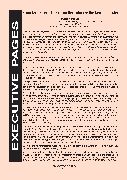EXECUTIVE PAGESFoam Dyeing with Indigo can Revolutionize the Denim Industry Dr. N.N. Mahapatra C.Col FSDC (UK), CText FTI (Manchester), FRSC (UK), FAIC (USA) Business Head (Dyes) Shree Pushkar Chemicals & Fertilisers Ltd. Mumbai Foam dyeing technology is not new and has been available in the market, though major advancements have been made in recent years. Foam dyeing is an attractive alternative to traditional dyeing methods due to the potential environmental benefits and supply chain savings. The main dyeing element in this process is foam, using air instead of water to carry the chemistry or dye onto the fabric. Foam systems can also be used to apply fabric finishes and are used for many different cotton fabrics, including knits, wovens, and denim. Major advancements in foam chemistry, generation, and application control have been made to allow for increased mill adoption for this technology. Foam dyeing with indigo eliminates the use of several chemicals, but still allows for traditional processes, wash downs and effects seen with traditionally dyed indigo fabrics. Think about classic blue jeans. The rich color comes from indigo, and it’s so ubiquitous both in fashion and in the American cultural imagination that it’s easy to imagine denim cloth as a naturally occurring phenomenon. It’s not. To get that blue-jean hue, the yarn that’s eventually woven into denim has to be pulled through a dozen boxes, each filled with up to 2,000 liters of liquid dye and water, lined up to reach the collective length of a football field. Textile threads require multiple exposures to indigo dye to truly absorb the color, and this system is used across the industry as the foundation for one of the most popular pieces of clothing across the world. Wrangler, which has been making western-style blue jeans since 1947, is now breaking with this manu- facturing tradition. The brand, along with jeans company Lee, was an early investor in a new method of denim dyeing, developed at Texas Tech, that foregoes the yards of dye vats for a more streamlined process that transmits indigo dye via foam. The denim industry is constantly evolving to incorporate new technologies, processes and production methods, many of which are efforts to improve sustainability throughout the supply chain. Thanks to industry-wide collaboration, a new method of indigo dyeing is now commercially available. Indigo foam dyeing originated at the university level and has moved through testing and trials and is about to be debuted in production after many years of research. Wrangler recently announced that they are releasing a “Dry Indigo Denim” collection in 2019 featuring foam dyed denim fabrics from the Spanish mill Tejidos Royo. The dyeing machines are from U.S.-based Gaston Mills, using a patented technique called IndigoZERO™ developed by Indigo Mill Designs. Indigo Mill Designs originally partnered with Texas Tech University on development and trials of this technology, and is able to dye both light and dark shades of denim. This technology adoption is a great example of how collaboration at all stages can bring a new technology, idea, or innovation to market and has the potential to change an industry. “The significance of this new foam-dye process is really predicated on what it replaced,” says Roian Atwood, Wrangler’s director of sustainability. The company estimates that the new method, which they call “Indigood,” eliminates over 99% of water from the dyeing process. In the foam-dyeing method, the yarn is passed through three chambers, where its sprayed with foam infused with indigo dye. The cham- bers are completely sealed and filled with nitrogen, which helps the dye absorb into the yarn. To roll out this innovative new dyeing process, Wrangler worked with a mill in Valencia, Spain called Tejidos Royo, that became the first textile operation to host the new method. By dyeing denim with indigo foam, instead of massive vats of liquid dye, Wrangler is working to cut nearly all wastewater out of the jeans-making process. Not only does the foam dyeing method do away with the potential for water waste at the end of the manufacturing process, which is one of the most environmentally damaging aspects of one of the world’s most resource-intensive industries, but it drives down energy usage, too. According to Wrangler, the foam dyeing process requires 60% less energy and mitigates waste by the same percentage. IMD’s foam- NCM-OCTOBER 2021 11
